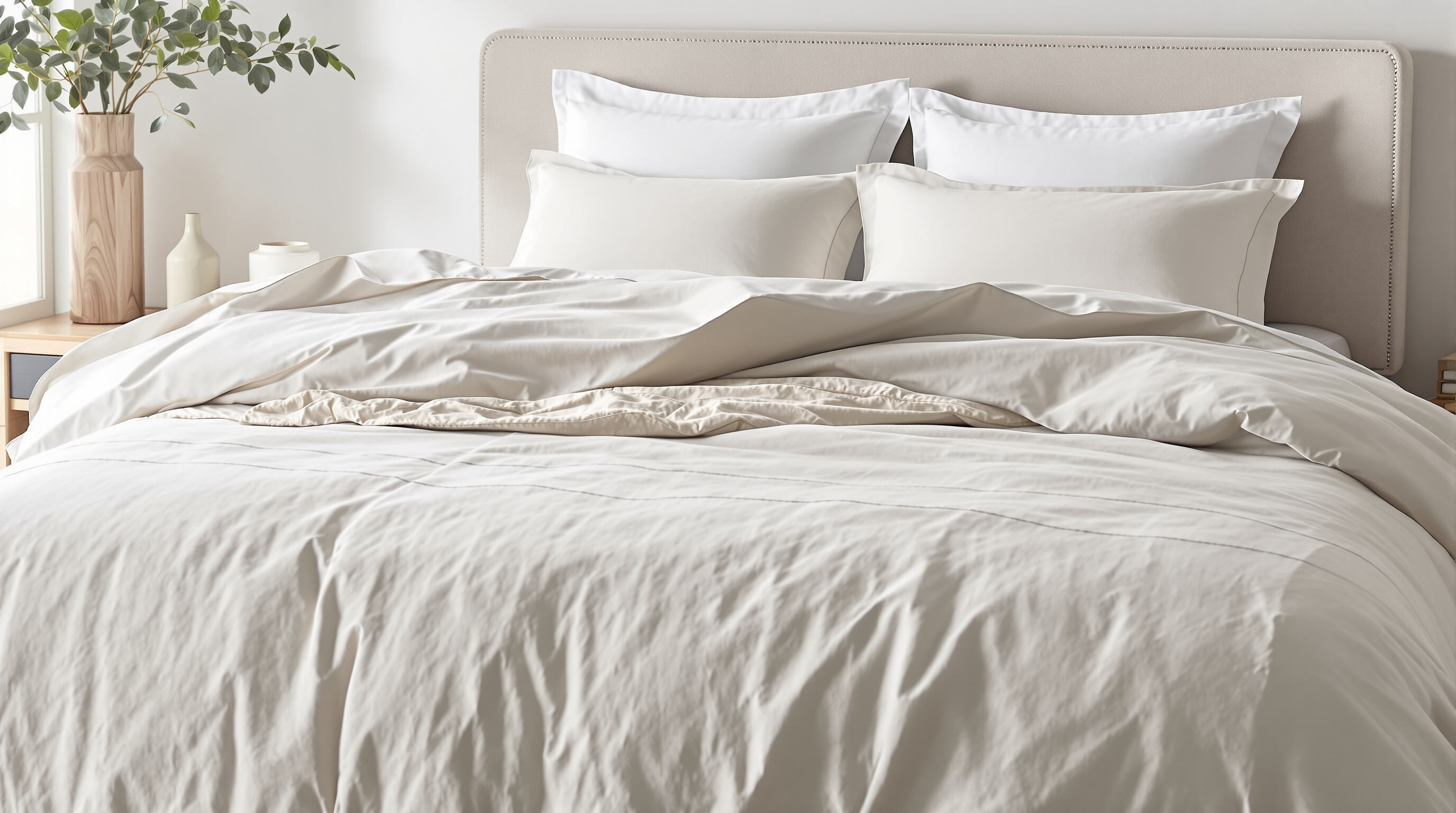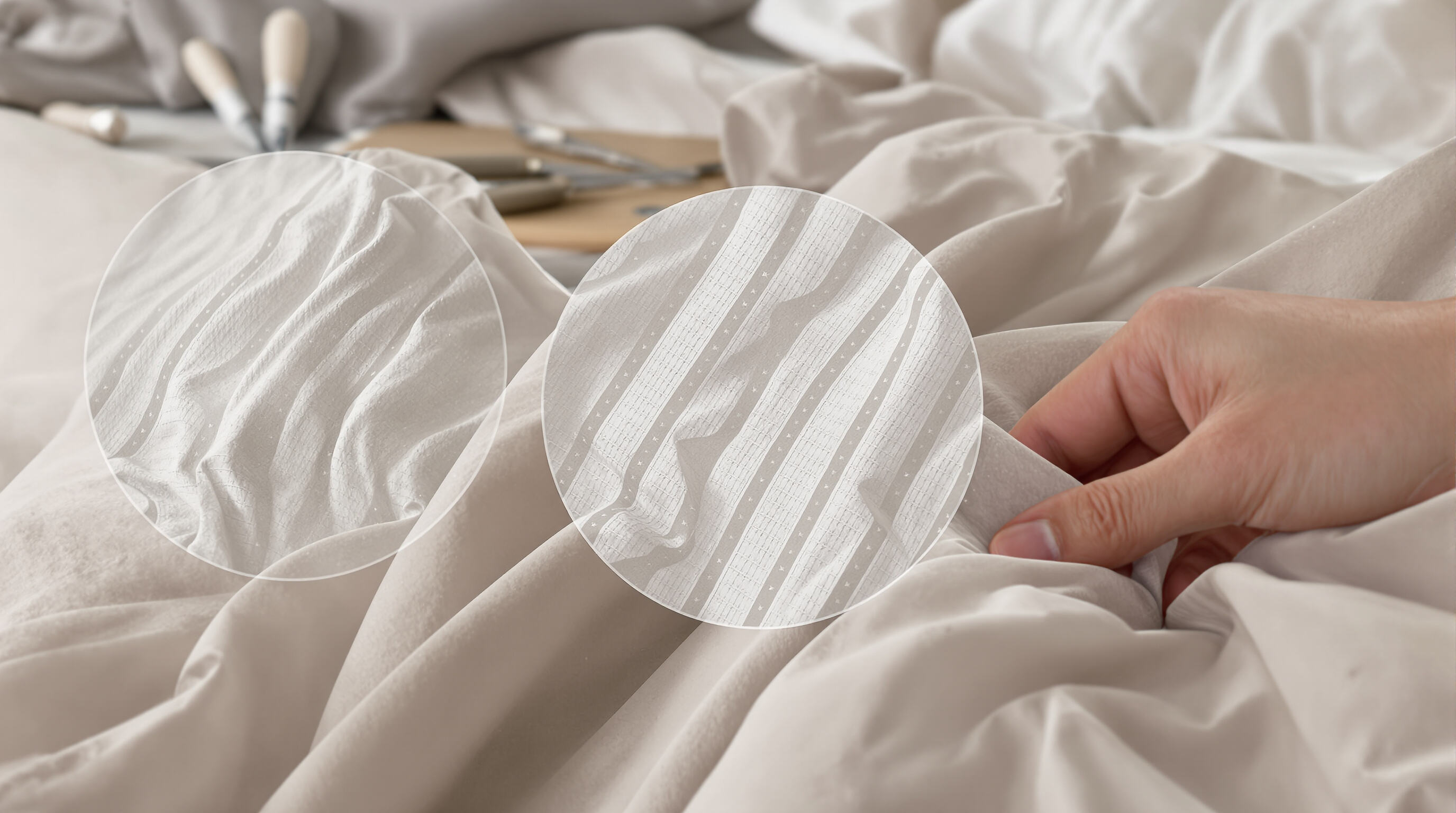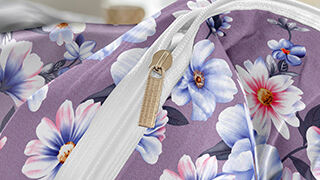Understanding Material Types for Luxury Duvet Covers

Cotton, Linen, Bamboo, and Eucalyptus: Comparing Natural Fibers for Premium Comfort
What makes a luxury duvet cover truly luxurious starts with what it's made from. Cotton is still king when it comes to staying comfortable all year round thanks to how breathable and soft it feels against the skin. The longer fibers found in Egyptian cotton versions mean these covers last longer too. Linen brings something special to the table as well. Its natural texture allows air to flow through better than most synthetics, studies from last year showed around 25% improvement in airflow actually. Plus linen doesn't need nearly as many chemicals during production. Bamboo viscose is becoming quite popular lately as an eco-friendly option. These covers soak up moisture about 40% better than regular cotton does, plus they have this amazing silky feel that drapes beautifully over bedding. For people with sensitive skin, eucalyptus-based fabrics are worth considering. They meet those strict OEKO-TEX safety standards and naturally resist bacteria growth, making them great for anyone prone to irritation or allergies.
Breathability, Softness, and Temperature Regulation in High-End Fabrics
The best quality fabrics are designed with climate considerations in mind, thanks to their unique fiber construction. Take linen for instance its natural hollow fibers actually form tiny air pockets that help keep things cool when humidity levels rise, cutting down on heat retention by around 18%. For those who want something that stays comfortable over time, long staple cotton options such as Supima remain soft even after being washed over 100 times without developing those annoying little pills. And then there's bamboo fabric which has this amazing micro-gapped structure that draws sweat away from the skin at least twice as fast as most polyester mixtures. Sleep studies conducted last year confirmed this benefit, showing why so many people are switching to these materials for better night's rest.
Sateen, Percale, and Silky Finishes: How Weave Affects Feel and Performance
Weave patterns directly influence tactile experience and functionality:
| Weave Type | Threads Per Inch | Surface Feel | Best For |
|---|---|---|---|
| Sateen | 300+ | Lustrous/Silky | Cold Climate Comfort |
| Percale | 200-300 | Crisp/Cool | Hot Sleepers |
| Twill | 150-200 | Durable/Matte | Frequent Washers |
Sateen’s one-yarn-under, three-yarn-over pattern creates a luminous surface that reflects 40% more light than percale weaves.
Durability and Long-Term Comfort of Luxury Natural Fibers
Investment-grade bedding materials demonstrate remarkable resilience:
- Egyptian cotton withstands 2.5x more wash cycles than standard cotton before showing wear
- Belgian linen gains softness through use while maintaining structural integrity for 5—7 years
- Bamboo lyocell retains 92% tensile strength after 50 industrial washes (2024 Textile Lab Report)
These natural fibers develop richer patinas over time, unlike synthetic alternatives that degrade with repeated laundering.
Thread Count, Fabric Quality, and Construction Essentials

Thread Count Myths vs. Reality: What Truly Defines Luxury Fabric Quality
Thread count is still pretty confusing for people shopping for fancy duvet covers. Some companies out there are pushing these super high numbers like 1,000 and above, but folks who actually know what they're talking about at The Spruce say real good stuff happens around 400 to 600 threads per square inch. Once we go past that sweet spot, many brands start cutting corners by using skinnier yarns that have been twisted together multiple times or just plain old cheating with their counting techniques. What does this mean? Less airflow and weaker fabric over time, which nobody wants when they spend money on something supposed to last.
What makes something truly luxurious? Well, it really comes down to two main things fiber length and how well the fabric holds together. The longer the cotton fibers are, the better they perform. Take Egyptian cotton for example these premium varieties have those extra long fibers which means smoother threads that just don't pill as easily. When looking at bedding materials, dense weaves matter too. Percale and sateen fabrics are what most high quality sheets use because they manage to be both soft and durable over time. Industry research from last year showed something interesting about this topic. About 72 percent of expensive duvet covers made with 500 thread count single ply construction kept their original look and shape even after being washed fifty times or more. That actually beats out many cheaper options labeled with higher thread counts like 800+ that tend to fall apart faster.
Single-Ply vs. Multi-Ply Yarns and the Role of Weave Density
Luxury fabric designers often go for single ply yarns made from straight fibers because they breathe better and feel lighter against the skin. According to that recent article in NYMag about fabrics, budget bedding usually has these thicker multi ply yarns that actually weigh things down and tend to hold onto heat and sweat, making them pretty bad at keeping people cool. Take sateen weave for instance. When made with single ply threads instead of the heavier multi ply stuff, it lets air flow through about 30 percent more freely. That makes a real difference when trying to stay comfortable during those hot summer nights.
Weave density also determines durability. Percale’s tight, one-over-one-under pattern withstands frequent washing without fraying, while looser linen-style weaves require gentler care. High-quality manufacturers disclose both thread count and weave type, allowing buyers to prioritize features like moisture-wicking (percale) or thermal retention (sateen) based on sleep needs.
Perfect Fit and Insert Security: Size, Design, and Closure Options
A perfectly fitted luxury duvet cover requires attention to three fundamentals: precise sizing, thoughtful construction, and secure closure systems.
Choosing the Right Size: Standard, Queen, King, and Specialty Dimensions
Mismatched duvet covers lead to shifting inserts and uneven comfort. While Standard (66"x86"), Queen (90"x90"), and King (106"x92") sizes dominate the market, specialty mattresses like California King (72"x84") or European styles demand custom dimensions. Measure your insert precisely — a 2—4" buffer prevents overstuffing while ensuring full coverage.
Baffle-Box Construction and Corner Loops for No-Shift Performance
Baffle-box designs use vertical fabric walls between top and bottom layers, creating chambers that prevent down or alternative fills from clumping. Combined with reinforced corner loops that anchor the insert to the cover, this construction reduces nightly adjustments by 58% compared to standard sewn-through styles.
Zipper, Button, and Snap Closures: Balancing Security and Aesthetics
Closure type impacts both function and visual appeal:
- Hidden zippers (18—22 teeth/inch) offer sleek profiles and secure seals but require delicate laundering
- Mother-of-pearl buttons elevate elegance but demand precise alignment
- Magnetic snaps enable quick changes but suit lighter fills best
Prioritize closures with double-stitched reinforcement at stress points to prevent seam splits, a common failure point after 50+ washes.
Sustainability, Certifications, and Ethical Sourcing in Luxury Bedding
OEKO-TEX, GOTS, and Hypoallergenic Standards: What Certifications Mean for You
Anyone serious about buying a luxury duvet cover should check for certain certifications first. The big ones to watch out for are OEKO-TEX Standard 100 and GOTS, which stands for Global Organic Textile Standard. These aren't just nice to have they really matter when it comes to both safety and how green the product actually is. OEKO-TEX testing makes sure the fabric doesn't contain those nasty chemicals we all want to avoid, something that meets even the tough standards set by the European Union for textile products. Then there's GOTS, which takes things a step further by demanding that at minimum 70 percent of the material comes from organic sources while also ensuring workers involved in production are treated fairly. People who suffer from allergies might want to specifically seek out covers labeled as hypoallergenic. This basically means the materials won't attract dust mites and are free from animal dander too, making them much better suited for sensitive skin.
Recent studies show 83% of consumers prioritize third-party certifications when purchasing premium bedding, with GOTS emerging as the gold standard for luxury brands adopting circular production models.
Eco-Friendly Practices and Ethical Production in Premium Duvet Cover Manufacturing
Many top manufacturers are mixing natural stuff such as organic cotton with newer methods that save water during dyeing and systems that recycle almost everything back into production to cut down on waste. When we talk about ethical sourcing, it's not just about what goes into the fabric itself. Fair pay for the people making these products matters too. Factories need to switch to solar power or other green energy sources instead of relying on fossil fuels. Even the packaging should eventually disappear naturally without leaving plastic behind. Look at companies which actually share their whole story about where things come from and how they're made. The truth is that when brands take responsibility for their supply chains, it makes a real difference for our planet and creates bedding that lasts much longer than cheap alternatives.
Care, Longevity, and Maintaining the Luxury Duvet Cover Experience
Washing, Drying, and Wrinkle Resistance: Practical Care for High-End Fabrics
Keeping a luxury duvet cover looking great begins with how it gets cleaned. Using cold water and gentle soaps helps keep those fancy fibers intact. A recent look at fabric care showed something interesting: around four out of five premium textiles stayed soft even after being washed over fifty times when treated this way. Heat is actually the enemy here. Letting natural stuff like Egyptian cotton sit in hot dryers for too long can cause it to shrink by about three percent. When dealing with materials prone to wrinkles such as linen, take them out of the dryer quickly and work out any creases while they're still a bit moist. Some tests have shown that these linen covers do get softer with regular use, though most start showing noticeable wrinkles within half a year if washed often.
Stain Resistance and Fabric Preservation Tips for Long-Term Elegance
| Stain Type | Immediate Action | Long-Term Solution |
|---|---|---|
| Oil-based | Blot with cornstarch | Professional dry cleaning |
| Acidic (coffee) | Rinse with cold water + baking soda | Enzyme-based detergent soak |
| Protein (makeup) | Dab with diluted white vinegar | Oxygen bleach treatment |
Controlled stain testing shows coffee residues fully dissolve with prompt treatment, while oils and cosmetics require targeted methods. To maintain fabric integrity, rotate covers seasonally and store in breathable cotton bags to prevent yellowing.
FAQ Section
What are the main benefits of using natural fibers for luxury duvet covers?
Natural fibers like cotton, linen, bamboo, and eucalyptus offer premium comfort, breathability, and temperature regulation. They are also more environmentally friendly and tend to resist bacteria growth, making them suitable for sensitive skin.
How does weave pattern affect the feel of a luxury duvet cover?
Weave patterns such as sateen, percale, and twill influence the tactile experience and functionality. For instance, sateen has a silky feel suited for colder climates, while percale is crisp and cool for hot sleepers.
What thread count is ideal for luxury duvet covers?
The ideal thread count for luxury duvet covers usually falls between 400 to 600 threads per square inch. Beyond this range, brands may cut corners, resulting in less durable fabrics.
Are certifications important when buying luxury duvet covers?
Certifications such as OEKO-TEX and GOTS ensure that the duvet covers meet safety standards and are produced using eco-friendly practices. These certifications are important for those who prioritize sustainability and ethical production.
Table of Contents
- Understanding Material Types for Luxury Duvet Covers
- Thread Count, Fabric Quality, and Construction Essentials
- Perfect Fit and Insert Security: Size, Design, and Closure Options
- Sustainability, Certifications, and Ethical Sourcing in Luxury Bedding
- Care, Longevity, and Maintaining the Luxury Duvet Cover Experience
- FAQ Section








